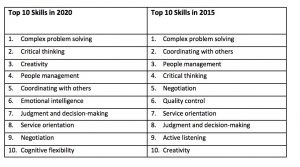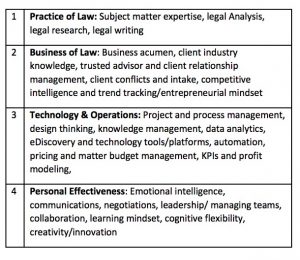The Skills Gap Part 1: What Competencies will Lawyers Need to Stay Relevant in the Future?
Our last three posts have addressed different aspects of innovation that are occuring in the legal profession: Innovation Part 1: What It Is and What It Isn’t, Innovation Part 2: Insights from Expertsand Innovation Part 3: ALSPs Are Expanding and Aren’t Alternative Anymore. Inherent in all of this client-driven change and digital transformation is the concept that more and different skills will be required for lawyers and law firms to remain viable and successful.
Core Related Work Skills of the Future
The World Economic Forum Future of Jobs report examines Employment, Skills and Workforce Strategy for the Fourth Industrial Revolution. In its most recent report, it notes the top ten skills that will be required in 2020 and reflects the shift, and in a few cases displacement, of the top 10 skills of 2015.

You will notice that Creativity moved from #10 to #3 and new to the top 10 list were Emotional Intelligence and Cognitive Flexibility (defined as the ability to generate or use different sets of rules for combining or grouping things in different ways.) Lawyers usually are known to be strong in complex problem-solving (#1,) critical thinking (#2,) judgment and decision-making (#7) and negotiation (#9.) They typically are not always as skilled or competent in creativity (#3,) people management (#4,) emotional intelligence (#6,) and cognitive flexibility (#10.)
The Lawyer Skill Gap
As Mark Cohen noted in his article, How Will Legal Education and Training Keep Pace with Change, “knowledge of law” is no longer enough, and the practice of law is shifting to the “business delivery of legal services.” Five years ago we wrote a blog post entitled Are You a T- or I-Shaped Lawyer? In it, we posited that T-shaped professionals have trans-disciplinary knowledge that is both broad and deep – they are experts in their field but also can and need to think broadly about other disciplines. The skills in the vertical of the T were practice specific knowledge and expertise, reflecting the increased need for specialization in practice and industry niches. This used to be the primary focus for skilled lawyers. In the last twenty years, we recognized the need for broader skills across the top of the T that were embodied by many rainmakers and client relationship champions.

In 2014, R. Amani Smathers introduced his concept of a T-shaped model in which the T encompasses technology and workflow skills such as design thinking, data analytics, project management, appreciation of code development, ability to communicate effectively. He added numerous business and innovation skills to the vertical including industry knowledge and skills, entrepreneurial and intrapreneurial skills, and ability to develop skills in new areas in and around the law.
While this was a very effective way of demonstrating the ever-expanding skills needed by lawyers, it incorporates too many skills into two categories and the vertical categories were broad and not well-defined.

In trying to decipher and frame the new competency requirements, we explored moving from an I-shaped to T-shaped, to Pi-shaped to Comb-shaped. But who wants to be called a Pi-shaped or Comb-shaped lawyer?!

In our efforts to develop a better way to define the range of competencies needed, we came across The Delta Model that was initially developed by a team spearheaded by Dan Linna, a professor at Northwestern Pritzker School of Law and was joined by Alyson Carrel and Jesse Bowman (also of Northwestern,) Shellie Reid of Northern Virginia Legal Services and Jordan Galvin of Mayer Brown, Knowledge Management. After conducting additional research and with added insights from Caitlin Moon of Vanderbilt Law School, Gabriel Teninbaum at Suffolk Law School and Natalie Runyon of Thompson Reutter, the group released its Delta Model 2.0 in March 2019. One of their primary findings was that Personal Effectiveness skills are the most important lawyer competencies. The Delta Model model breaks lawyer competencies into three buckets:
- Personal Effectiveness:
- Relationship Management
- Entrepreneurial Mindset
- Emotional Intelligence
- Communication
- Character
- Business and Operations:
- Business Fundamentals
- Project Management
- Data Analytics
- The Law:
- Subject Matter Expertise
- Legal Research
- Legal Analysis
- Legal Writing

The Delta Model team is comprised of Alyson Carrel of Northwestern Pritzker School of Law, Shellie Reid of Northern Virginia Legal Services, Caitlin “Cat” Moon of Vanderbilt Law School and Gabriel Teninbaum at Suffolk Law School.
From 3-Sided Delta Model to 4-Sided Tetrahedron Model
While the Delta Model goes a long way to further detailing the kinds of skills required in addition to legal practice skills and technology/process skills, we believe that this model clumps too much into two of the three categories and that a fourth bucket is justified. We propose a four-sided tetrahedron shape that still puts the practice of law as the base foundation but adds three additional buckets:
- Practice of Law (base)
- Business of Law
- Technology and Operations
- Personal Effectiveness.


In this model, the Business of Law bucket focuses externally more on the client, commerciality, what lawyers need to know to better serve clients, build trusted relationships, anticipate their needs and be better informed about industry and business trends.
What Does this Mean for Leaders and Talent Officers in Law Firms?
This has implications for law firms in a number of areas and we offer the following recommendations:
- Call a meeting of your top talent professionals and partner leadership to actively explore and identify the skills your firm needs now and in the future
- Once skills have been identified, determine which of these will be required and carried out by traditional lawyers from traditional law schools versus law school graduates with new model skills as well as other technical professionals that do not require a law school degree
- Revise your recruiting criteria and talent pipeline to reflect new skills sets required for the future
- Adjust your recruiting process and the schools/employers from which you recruit
- Hire students who have participated both in course work and experiential internships in legal operations, legal informatics, technology and innovation (see next post)
- Modify your training and professional development curriculum
- Develop a more robust rotation and client secondment program
- Train/retool your existing lawyers, including partners
- Collaborate with your clients! Their lawyers need the same skills training as your lawyers do.
- Open the doors – bring together all of your talent across the firm including your professionals who support back and front office functions
In our next blog post, The Skills Gap Part 2, we will look at how some of the progressive law schools, institutes and law firms are providing courses, boot camps, experiential learning and innovation labs to facilitate innovation learning by students and new and experienced lawyers.

